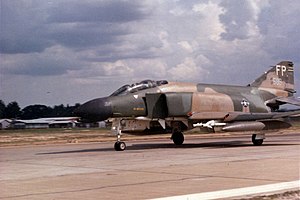
Back Аперацыя «Бола» BE Operace Bolo Czech Operaatio Bolo Finnish Opération Bolo French Операция «Боло» Russian Chiến dịch Bolo VI
| Operation Bolo | |||||||
|---|---|---|---|---|---|---|---|
| Part of Vietnam War | |||||||
 8th TFW F-4C Phantom II, c. 1967 | |||||||
| |||||||
| Belligerents | |||||||
|
|
| ||||||
| Commanders and leaders | |||||||
|
Robin Olds Daniel James, Jr. | Tran Manh | ||||||
| Strength | |||||||
|
56 F-4C Phantom IIs (28 participated) |
16 MiG-21 'Fishbeds' (8 or 9 engaged) | ||||||
| Casualties and losses | |||||||
| None |
US claim: 5 MiG-21PFL lost (c/n 1812, 1908, 1909, 2106, 2206) | ||||||
Operation Bolo was a United States Air Force mission during the Vietnam War, considered to be a successful combat ruse.[1]
The mission was a response to the heavy losses sustained during the Operation Rolling Thunder aerial-bombardment campaign of 1966, during which Vietnam People's Air Force fighter jets had evaded U.S. escort fighters and attacked U.S. bombers flying predictable routes. On 2 January 1967, U.S. Air Force F-4 Phantom II multirole fighters flew a mission along flight paths typically used by the bombers during Rolling Thunder. The ruse drew an attack by Vietnamese Mikoyan-Gurevich MiG-21 interceptors, whose pilots expected to find heavily loaded fighter-bombers. Instead, they were met by the far more agile F-4s, which shot down seven of the MiGs.
The battle prompted VPAF pilots and strategists, as well as Soviet tacticians, to re-evaluate the tactics and deployment of the MiG-21.
- ^ Futrell, R. Frank; Greenhalgh, William H.; Grubb, Carl; Hasselwander, Gerard E.; Jakob, Robert F.; Ravenstein, Charles A. (January 1976). Eastman, James N.; Hanak, Walter; Paszek, Lawrence J. (eds.). United States Air Force in Southeast Asia 1965-1973. Aces and Aerial Victories. Washington, D.C.: Office of Air Force History. OCLC 18844042 – via Defense Technical Information Center. https://apps.dtic.mil/sti/citations/tr/ADA476450.